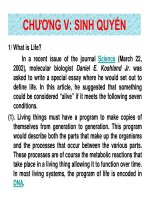Bài giảng Kinh tế môi trường: Chương 2 - ĐH Kinh tế
Bạn đang xem bản rút gọn của tài liệu. Xem và tải ngay bản đầy đủ của tài liệu tại đây (571.69 KB, 14 trang )
Bộ môn Kinh tế Môi trường, Nông nghiệp và Tài nguyên
(Department of Environmental, Agricultural, and Resource Economics)
1A Hoàng Diệu, Phú Nhuận, Tp.HCM
Môn học: Kinh tế môi trường
Sơ lược lịch sử kinh tế
môi trường
Nội dung
1. Giai đoạn trước 1960
2. Giai đoạn sau 1960
Giai đoạn trước 1960
▪ Sandmo (2015). The early history of
environmental economics. Review of
Environmental Economics and Policy, Vol.9:
43-63.
An eighteenth century forerunner:
Marquis de Condorcet (1776)
▪ Awareness of the links between economic
activity and environmental quality.
▪ A pioneer in the use of externality arguments
for policy analysis of environmental policy (i.g.
forbidding harmful economic activities,
restricting property rights, undertaking public
works).
▪ However, public intervention was based on
social justice, not efficiency.
The classical school: From Smith to Mill
▪ Adam Smith (1776): Theory of the invisible
hand, and the provision of public goods through
government action.
▪ Thomas Malthus (1798): Theory of population
provided inspiration for later economists to
grapple with the issue of resource scarcity and
economic development.
▪ David Ricardo (1817): Theory of land rent
regarding both agriculture and mining became
of great importance for future development of
environmental economics.
The classical school: From Smith to Mill
▪ John Mill (1848) emphasized the public
nature of the natural environment and the
tasks of the government; and expressed
strong support for preserving the natural
environment.
▪ Perspectives on the classical economists: An
early awareness of the environmental
problems and a belief that public policy could
improve the market outcome.
Practical applications: Edwin Chadwick
(1800 – 1890)
▪ A civil servant (not economist) was much
influenced by the utilitarian philosopher
Jeremy Bentham and John S. Mill.
▪ Utilized classical price theory (incentivebased mechanisms) to design incentives for
environmental and social improvement.
Natural resource scarcity: William
Jevons and the coal question
▪ The lack (depletion) of coal would act as a brake
on the country’s economic growth.
▪ He explicitly linked the present and future price
of coal to the cost of extraction.
▪ It is just possible that some day the sunbeams
may be collected, or that some source of energy
now unknown may be detected (Jevons, 1865).
The marginalist revolution and the
evironment
▪ Alfred Marshall (1890): Initial formulation of
externality concept. He realized that in the
presence of externalities, the market
equilibrium will no longer be socially
efficient.
▪ Marshall’s effort on fisheries pioneers the
study the economics of a common property
resource.
Arthur Pigou (1920) and the foundations
of environmental economics
▪ Further developed the theory of externalities.
▪ Analyzed how the choice of policies, particularly
taxes, could improve the efficiency of resource
allocation.
▪ Discussed the empirical measurement of
environmental damage.
▪ Called for subsidies to afforestation as an
instrument for global climate policy.
▪ Suggested other policy options like prohibition of
the production and consumption.
The emergence of natural resource
economics
▪ Scott Gordon (1954). The economic theory
of a common-property resource: The
fishery. Journal of Political Economy,
Vol.62.
▪ Harold Hotelling (1931). The economics of
exhaustible resources. Journal of Political
Economy, Vol. 39.
Paul Samuelson (1954) and the theory
of public goods
▪ The environmental benefit-cost analysis is
the practical application of the
fundamental ideas in the theory of public
goods.
Giai đoạn sau 1960
▪ Pearce (2002). An intellectual history of
environmental economics. Annu. Rev. Enery
Environ, Vol. 27: 57-81.
- The establishment of RFF (resources for future)
organization in 1952
- Silent Spring by Rachel Carson in 1962
- Material balance model by Robert Ayres and
Allen Kneese 1969
- Property rights and transaction costs by Ronald
Coase 1960
Giai đoạn sau 1960
▪ The strategy of the commons by Garrett
Hardin
▪ Passive use value by Krutilla 1967
▪ Polluter pays principle by OECD 1972
▪ Marketable permits by John Dales 1968









